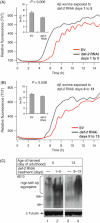Temporal requirements of insulin/IGF-1 signaling for proteotoxicity protection
- PMID: 20003171
- PMCID: PMC3026833
- DOI: 10.1111/j.1474-9726.2009.00541.x
Temporal requirements of insulin/IGF-1 signaling for proteotoxicity protection
Abstract
Toxic protein aggregation (proteotoxicity) is a unifying feature in the development of late-onset human neurodegenerative disorders. Reduction of insulin/IGF-1 signaling (IIS), a prominent lifespan, developmental and reproductive regulatory pathway, protects worms from proteotoxicity associated with the aggregation of the Alzheimer's disease-linked Abeta peptide. We utilized transgenic nematodes that express human Abeta and found that late life IIS reduction efficiently protects from Abeta toxicity without affecting development, reproduction or lifespan. To alleviate proteotoxic stress in the animal, the IIS requires heat shock factor (HSF)-1 to modulate a protein disaggregase, while DAF-16 regulates a presumptive active aggregase, raising the question of how these opposing activities could be co-regulated. One possibility is that HSF-1 and DAF-16 have distinct temporal requirements for protection from proteotoxicity. Using a conditional RNAi approach, we found an early requirement for HSF-1 that is distinct from the adult functions of DAF-16 for protection from proteotoxicity. Our data also indicate that late life IIS reduction can protect from proteotoxicity when it can no longer promote longevity, strengthening the prospect that IIS reduction might be a promising strategy for the treatment of neurodegenerative disorders caused by proteotoxicity.
Figures





Similar articles
-
Opposing activities protect against age-onset proteotoxicity.Science. 2006 Sep 15;313(5793):1604-10. doi: 10.1126/science.1124646. Epub 2006 Aug 10. Science. 2006. PMID: 16902091
-
Temporal requirements of heat shock factor-1 for longevity assurance.Aging Cell. 2012 Jun;11(3):491-9. doi: 10.1111/j.1474-9726.2012.00811.x. Epub 2012 Mar 19. Aging Cell. 2012. PMID: 22360389 Free PMC article.
-
Differential regulation of the heat shock factor 1 and DAF-16 by neuronal nhl-1 in the nematode C. elegans.Cell Rep. 2014 Dec 24;9(6):2192-205. doi: 10.1016/j.celrep.2014.11.028. Epub 2014 Dec 11. Cell Rep. 2014. PMID: 25497098
-
Central insulin and insulin-like growth factor-1 signaling: implications for diabetes associated dementia.Curr Diabetes Rev. 2011 Sep;7(5):356-66. doi: 10.2174/157339911797415594. Curr Diabetes Rev. 2011. PMID: 21916834 Review.
-
Insulin/insulin-like growth factor signaling in C. elegans.WormBook. 2013 Dec 26:1-43. doi: 10.1895/wormbook.1.164.1. WormBook. 2013. PMID: 24395814 Free PMC article. Review.
Cited by
-
Over-expression of heat shock factor 1 phenocopies the effect of chronic inhibition of TOR by rapamycin and is sufficient to ameliorate Alzheimer's-like deficits in mice modeling the disease.J Neurochem. 2013 Mar;124(6):880-93. doi: 10.1111/jnc.12080. Epub 2012 Dec 26. J Neurochem. 2013. PMID: 23121022 Free PMC article.
-
HIF-1-dependent regulation of lifespan in Caenorhabditis elegans by the acyl-CoA-binding protein MAA-1.Aging (Albany NY). 2017 Jul 27;9(7):1745-1769. doi: 10.18632/aging.101267. Aging (Albany NY). 2017. PMID: 28758895 Free PMC article.
-
The insulin/IGF signaling cascade modulates SUMOylation to regulate aging and proteostasis in Caenorhabditis elegans.Elife. 2018 Nov 7;7:e38635. doi: 10.7554/eLife.38635. Elife. 2018. PMID: 30403374 Free PMC article.
-
The Ubiquitin Ligase CHIP Integrates Proteostasis and Aging by Regulation of Insulin Receptor Turnover.Cell. 2017 Apr 20;169(3):470-482.e13. doi: 10.1016/j.cell.2017.04.003. Cell. 2017. PMID: 28431247 Free PMC article.
-
Gene expression modulation by the linker of nucleoskeleton and cytoskeleton complex contributes to proteostasis.Aging Cell. 2019 Dec;18(6):e13047. doi: 10.1111/acel.13047. Epub 2019 Oct 1. Aging Cell. 2019. PMID: 31576648 Free PMC article.
References
-
- Amaducci L, Tesco G. Aging as a major risk for degenerative diseases of the central nervous system. Curr. Opin. Neurol. 1994;7:283–286. - PubMed
-
- Bates G. Huntingtin aggregation and toxicity in Huntington’s disease. Lancet. 2003;361:1642–1644. - PubMed
-
- Bluher M, Kahn BB, Kahn CR. Science. Vol. 299. New York, NY: 2003. Extended longevity in mice lacking the insulin receptor in adipose tissue; pp. 572–574. - PubMed
-
- Brunet A, Sweeney LB, Sturgill JF, Chua KF, Greer PL, Lin Y, Tran H, Ross SE, Mostoslavsky R, Cohen HY, Hu LS, Cheng HL, Jedrychowski MP, Gygi SP, Sinclair DA, Alt FW, Greenberg ME. Science. Vol. 303. New York, NY: 2004. Stress-dependent regulation of FOXO transcription factors by the SIRT1 deacetylase; pp. 2011–2015. - PubMed
Publication types
MeSH terms
Substances
Grants and funding
LinkOut - more resources
Full Text Sources
Other Literature Sources
Miscellaneous

